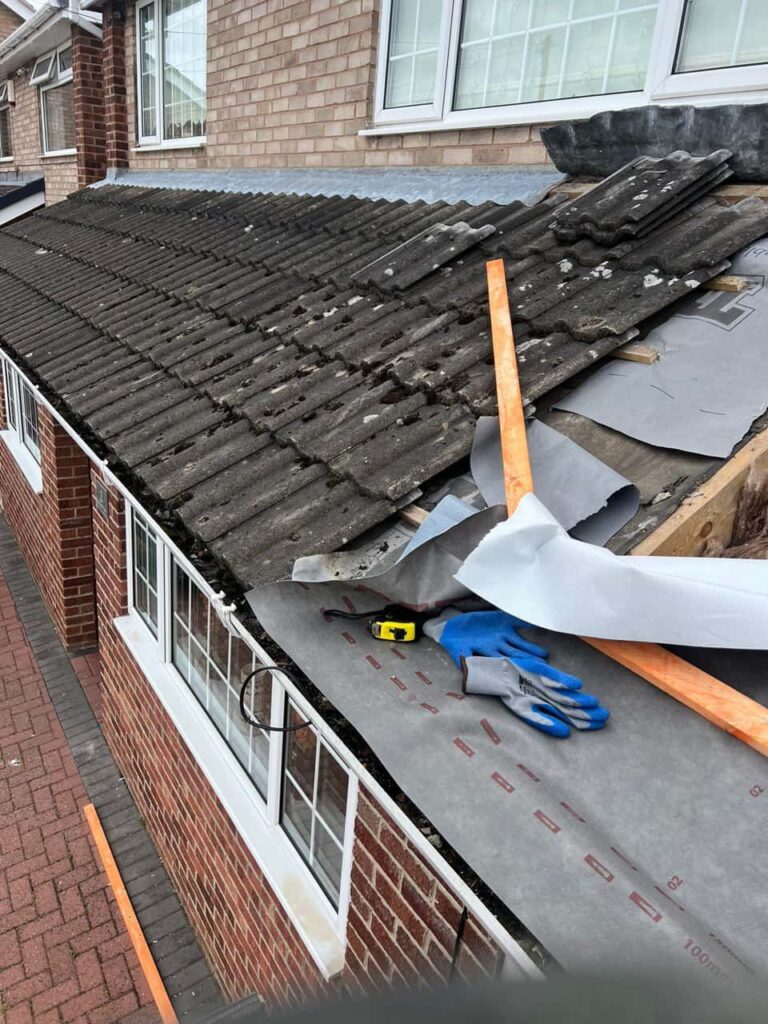When homeowners notice water stains on their ceiling or damp patches on their walls, the immediate assumption is often that there’s a simple leak somewhere in the roof. However, one of the most common and overlooked causes of roof leaks is slipped or displaced roof tiles. These seemingly minor defects can quickly lead to significant damage if not addressed promptly. At Edenbridge Roofing Repairs, we frequently see how slipped tiles and leaks are closely connected — and how early intervention can prevent much bigger problems down the line.
Understanding How Roof Tiles Protect Your Home
Roof tiles serve as the first line of defence between your property and the elements. They are carefully arranged in an overlapping pattern to create a watertight barrier, allowing rainwater to flow smoothly down into the guttering system. When even a single tile becomes loose, cracked, or misaligned, it creates a weak point in that protective layer.
Over time, rainwater can find its way beneath the tiles, soaking into the underlay and roof timbers. Once moisture breaches these layers, it can lead to leaks, damp, rot, and even structural deterioration. For homeowners in Edenbridge, Kent, this makes regular roof inspections by Edenbridge Roofing Repairs essential to maintaining a strong, watertight covering all year round.
What Causes Roof Tiles to Slip?
Slipped roof tiles are often the result of gradual wear rather than sudden failure. Understanding the causes can help homeowners take preventative action before damage occurs.
1. Weather and Environmental Conditions
Strong winds, heavy rain, frost, and temperature fluctuations all take their toll on roofing materials. Over time, wind can loosen fixings, while freeze-thaw cycles cause expansion and contraction, leading to tile displacement.
2. Deteriorated Fixings or Mortar
Many older roofs rely on mortar to secure ridge or hip tiles. As mortar ages, it becomes brittle and begins to crumble, leaving tiles unstable. Similarly, metal fixings or nails can corrode over the years, especially in damp or coastal environments.
3. Poor Installation
If tiles were not properly aligned or secured during installation, they are more prone to slipping. Even a small gap or uneven overlap can compromise the roof’s ability to repel water.
4. General Age and Wear
Roofing materials naturally deteriorate over time. Prolonged exposure to UV light and weathering gradually weakens both tiles and the supporting structure, increasing the likelihood of movement or cracks.
5. Animal or Debris Disturbance
Birds, squirrels, or falling branches can dislodge tiles, particularly near roof edges or chimneys. Regular inspections help identify these problems before they cause water ingress.
How Slipped Tiles Lead to Roof Leaks
A single slipped tile may seem minor, but it can quickly expose the layers beneath your roof to moisture. The process typically unfolds in several stages:
- Exposure of Underlay: Once a tile shifts or breaks, the roofing underlay is left vulnerable to rainwater. Although the underlay offers secondary protection, it’s not designed for prolonged water exposure.
- Water Penetration: Persistent rain can eventually soak through the underlay, reaching the roof timbers and insulation.
- Damp and Rot: Moisture trapped within the structure can cause timber decay, mould growth, and compromised insulation efficiency.
- Visible Interior Damage: Water stains, peeling paint, or bubbling plaster often indicate that the problem has reached inside the property.
At this stage, the issue is no longer just about a slipped tile — it’s a full roof leak that requires urgent attention from a professional roofing company such as Edenbridge Roofing Repairs.
Shared Warning Signs of Slipped Tiles and Roof Leaks
Both slipped tiles and leaks often present similar symptoms. Recognising these early can help prevent costly repairs later.
Key Warning Signs Include:
- Damp patches on ceilings or walls after rainfall
- Missing, cracked, or misaligned tiles visible from the ground
- Water dripping from the attic or roof space
- Musty odours or signs of mould growth
- Daylight visible through roof boards when viewed from the loft
- Debris such as broken tiles or mortar found in the guttering
If you notice any of these signs, it’s important to arrange a professional inspection promptly. Delaying even small repairs can allow water to spread and cause further deterioration.
The Role of Regular Roof Inspections
Regular roof inspections are one of the most effective ways to prevent both tile slippage and leaks. During an inspection, roofing specialists like Edenbridge Roofing Repairs check for:
- Loose, cracked, or displaced tiles
- Corroded fixings and mortar failure
- Damaged flashing around chimneys and valleys
- Blocked gutters and poor drainage
- Weak points in the underlay or roof structure
Early identification allows for minor repairs, such as re-securing or replacing individual tiles, before they escalate into more extensive roof damage.
Professional Solutions for Slipped Tiles and Leaks
At Edenbridge Roofing Repairs, we approach every repair with precision and care to ensure long-lasting results. Our team begins by identifying the root cause of the problem — whether it’s worn fixings, failed underlay, or environmental stress — and then provides targeted solutions that restore full weatherproofing.
Our Professional Repair Process Typically Includes:
- Inspection and Assessment: Determining the extent of damage and identifying any underlying weaknesses.
- Tile Refixing or Replacement: Replacing damaged or missing tiles and ensuring proper alignment for effective water drainage.
- Underlay and Flashing Repair: Restoring the protective layers beneath the tiles and sealing vulnerable junctions.
- Gutter and Roofline Check: Ensuring effective water flow to prevent pooling or overflow that could lead to further leaks.
This comprehensive approach ensures not only that visible issues are resolved but also that the roof is structurally sound and protected against future leaks.
Preventing Future Problems
Prevention is always better than cure, especially when it comes to roofing. Homeowners can reduce the risk of tile slippage and leaks by:
- Scheduling routine roof inspections, particularly after storms or harsh weather
- Clearing gutters and downpipes to ensure proper drainage
- Keeping nearby trees trimmed to reduce debris impact
- Checking loft spaces periodically for early signs of moisture or staining
Edenbridge Roofing Repairs offers tailored maintenance advice to help property owners in Edenbridge, Kent, keep their roofs in top condition all year round.
The Connection Between Slipped Tiles and Roof Leaks
In essence, slipped tiles and roof leaks are two sides of the same problem — one causes the other. A single misplaced tile can compromise the roof’s watertight barrier, allowing water to infiltrate and cause progressive damage. Left untreated, what starts as a minor issue can develop into widespread damp and structural decay.
Professional repair and maintenance are therefore essential not just for fixing current leaks but for preventing them altogether.
Conclusion
Slipped tiles and roof leaks are closely connected, and both signal that your roof’s protective system has been compromised. Ignoring these issues can lead to costly water damage and structural deterioration. Regular inspections and professional repairs ensure your roof remains secure, watertight, and resilient against the elements. For expert tile repairs and leak prevention in Edenbridge, Kent, Edenbridge Roofing Repairs provides reliable, high-quality solutions that safeguard your home and offer lasting peace of mind.
Call us on: 01732 443 294
Click here to find out more about Edenbridge Roofing Repairs
Click here to complete our contact form and see how we can help with your roofing needs.

